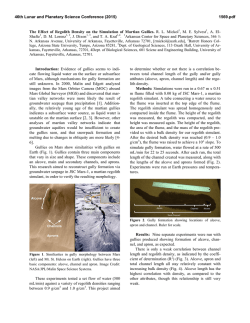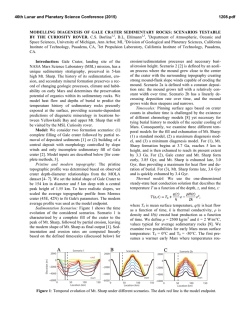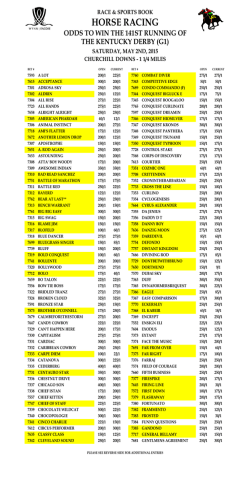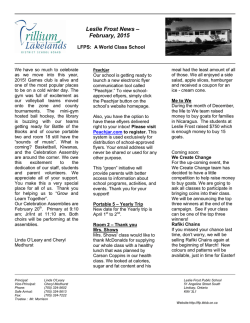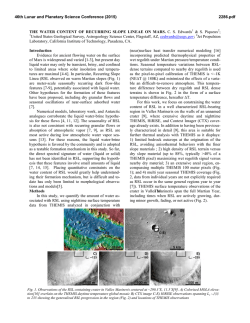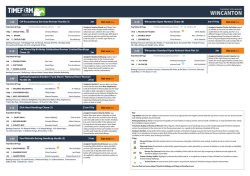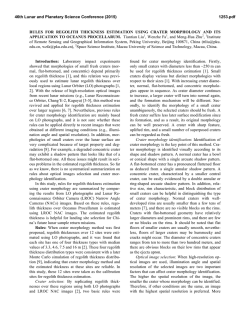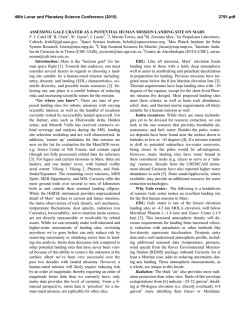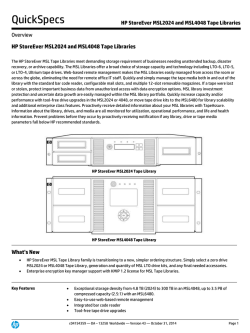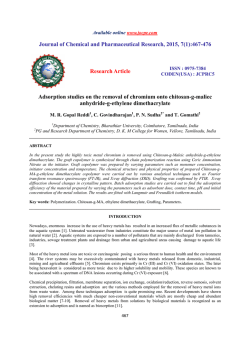
T e m p e ra tu re (K ) Relative Humidity RH (%)
46th Lunar and Planetary Science Conference (2015) 1110.pdf REGOLITH-ATMOSPHERE WATER VAPOR TRANSFER ON MARS: COMPARISON BETWEEN PHOENIX AND MSL DATA. M. B. Conner1,2, H. N. Farris1, V. F. Chevrier1, 1Arkansas Center for Space and Planetary Science, MUSE 202, University of Arkansas, Fayetteville, AR 72701, USA, 2Reed College 3203 Woodstock Blvd, Portland, OR, 97202. [email protected]. 280 Langmuir BET 260 Temperature (K) Introduction: The relative humidity (RH) data returned by Phoenix [1, 2] allowed the first detailed investigation of the diurnal water cycle in the polar region of Mars. Much has been discussed with regards to the water cycle on Mars, including an evaporationadsorption cycle where water molecules alternate between thin layers on the surface of regolith and water vapor in the air (Fig. 1). The most recent rover to visit Mars, Mars Science Laboratory (MSL), also returned detailed RH data in an equatorial region across a full Martian year. A comparison of the two data sets is warranted since the rovers are located in the two geographic extremes of the surface (polar vs. equatorial), which suggests that the two data sets should bracket the climate on the Martian surface. This abstract analyzes the Phoenix data using adsorption theories built on the foundation of regolith parameters [3]. The results of this analysis will then be compared to the MSL data. 240 220 200 180 100 10 1 0.1 0.01 Relative Humidity RH (%) Figure 2. Fit of Phoenix lander data using the Langmuir adsorption theory (blue line) for one monolayer of water molecules, and the BET theory (red line) for multilayer. The fit uses JSC Mars-1 simulant parameters shown in (Table 1) and ΔH ≈ 56 kJ mol-1. The resulting surface coverages are 0.15 and 0.32, respectively. At first glance the data (Fig. 2) suggest a logarithmic fit. To explain this relationship, two theoretical paths were taken: Langmuir and BET. Both are theories of adsorption that involve modeling liquids by layers; Langmuir only assumes a monolayer, while the more rigorous BET method allows for a multilayer construction. Beginning with the definition of RH for a Langmuir isotherm: (1) Figure 1. Comparison between top: the distribution of nanophase ferric oxides as seen by Mars Express OMEGA (high abundance: white, low: blue) [4] and bottom: the humidity in the atmosphere, ranging from 0 (blue) to ~30 (red), as observed by MGS-TES in the equatorial regions [5, 6]. The similarity of both maps suggests the ferric oxides abundant in the regolith could control the atmospheric humidity through adsorption and desorption [7]. Phoenix data: RH from Phoenix was taken with the Thermal and Electrical Conductivity Probe (TECP) instrument. The data came from the PDS for sols 0–150. Saturation vapor pressure (Psat) [8] was calculated using the board temperature, T, and will suffice as the atmospheric pressure. Computing the vapor pressure at the frost point temperature allowed for the calculation of the pressure of water (PH2O). Using these two calculations, RH (Eqn. 1) could then be found and plotted against the temperature (Fig. 2). where Psat has been shown to be a function of temperature and PH2O is the saturation vapor pressure for water ice and is given by rearranging the Langmuir equation: (2) Here θ is the surface coverage (or the fraction of the surface covered by water) and α is a parameter describing the regolith at a specific temperature. Knowing α at one temperature, one can find it at other temperatures with: (3) where R is the ideal gas constant, T is temperature, ΔH is the enthalpy, and Psat(T) is the saturation pressure at temperature T. The α values were calculated from C values given in (Pommerol et al., 2009) at T = 243K, 46th Lunar and Planetary Science Conference (2015) so α at any temperature could be calculated [7]. With this variable taken care of, a fit of the data could be made by adjusting the only two remaining variables: θ and ΔH. For the regolith JSC Mars-1 (α0 = 2.06), the curve fit the data at values of θ = 0.32 and ΔH ≈ 56 kJ (Fig. 2). A BET approach is analogous. Rearranging the BET equation and solving for RH 1110.pdf (6) where Psat,ice has been shown to be a function of temperature. At the frost point water vapor changes into ice, rather than liquid water like at higher temperatures, and becomes the dominant form of transfer. (4) Here θ is the volumetric coverage, and C is a constant that is defined as α times the saturation pressure. C can also be expressed as: (5) Equations (4) and (5), combined with C values for different regolith types again taken from (Pommerol et al., 2009), allowed for adjustment of θ and ΔH parameters in order to find the lind of best fit [7]. For the regolith JSC Mars-1 (C = 103.4 at T = 243 K), the curve fit the data at values of θ = 0.32 and ΔH ≈ 56 kJ (Fig. 2). Visually, the BET curve fits better than the Langmuir one and it encompasses the data points at the edge of the set. Figure 3. MSL data (green) and Phoenix data (orange) fit using the multilayer BET theory (blue) for JSC Mars-1 simulant parameters shown in Table 1 and, has a ΔH ≈ 56 kJ/mol and θ ≈ 0.33. MSL data: RH from MSL was taken with the Rover Environmental Monitoring Station (REMS) instrument. The data showed a similar trend of increasing humidity with decreasing temperature, though the trend of the data is much broader than the Phoenix data (Fig. 3). The fit using BET theory for the MSL data was not as clean and an additional component had to be added: the frost point. For the regolith JSC Mars1(C = 103.4 at T = 243 K), the BET curve fit the data at values of θ = 0.46 and ΔH ≈ 42 kJ (Fig. 4). At the triple point, the frost point takes over and accounts for the high humidities at low temperatures. The relative humidity at the frost point is given by the equation: Figure 4. MSL data represented using a point density display (yellow is high density, red low density). The majority of data points fall along the multilayer BET theory line (black) and a new frost point line (blue). The new fit follows the solid section of both lines. For JSC Mars-1 simulant parameters shown in Table 1 and fit produced ΔH ≈ 42 kJ/mol and θ ≈ 0.46. Conclusions: The trend in the data collected with Phoenix can be explained with the multilayer BET theory. This explanation holds when applying it to the MSL data, though a frost point must be included. The BET model describing the Phoenix data points results in θ ≈ 0.33 layers, and for MSL we find θ ≈ 0.46. These values are relatively consistent, and account for the “warmer” effects of MSL’s equatorial location. These values suggest liquid water can adsorb onto the surface, but in very small amounts. It should also be noted that one of the reasons we might see higher variability in the MSL data is that MSL is travelling, so the rover could encounter a variety to different climates and regolith types. References: [1] Hecht M. H. et al. (2009) Science 325, 64-67. [2] Chevrier V. et al. (2008) Icarus 196 (2), 459-476. [3] Brunauer S. et al. (1938) Journal of American Chemical Society 60 (2). 309-319. [4] Poulet F. et al. (2007) Journal of Geophysical Research. 112. [5] Jakosky B. M. et al. (2005) Icarus. 175, 58-67. [6] Smith, M. D. (2002) Journal of Geophysical Research. 107. [7] Pommerol et al. (2009) Icarus 204(1), 134136. [8] Feistel R., W. Wagner (2007) Geochim. Cosmochim. Acta 71, 36-45.
© Copyright 2026
